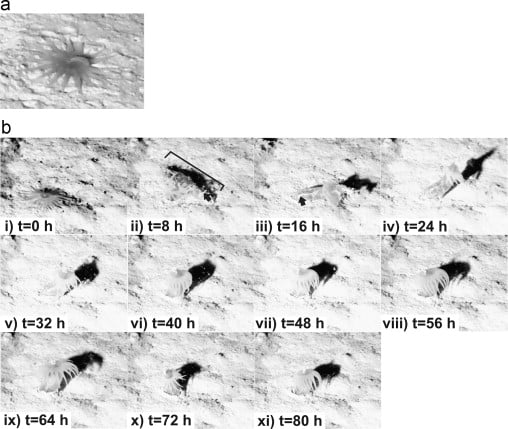New Footage Shows Mysterious Deep-Sea Anemone 3 Miles Below the Surface
![]()
Oceanic researchers used sophisticated camera traps to discover the hidden life of a predatory anemone that tunnels under the ground and hunts prey 15 times its size.
In the Porcupine Abyssal Plain, a bio-diverse seabed off the coast of Ireland almost 5,000 meters (about three miles) deep, scientists conduct challenging, long-running oceanic research in an effort to understand what creatures could survive the immense pressure at such a depth. The Porcupine Abyssal Plain Sustained Observatory (PAP-SO) built a hybrid monitoring station in the 1990s which includes multiple moored instrument systems, robotic submarines, as well as both camera and video devices.
ABC News reports that, building upon over 30 years of data, new time-lapse footage shows Iosactis vagabunda, a fascinating deep-sea anemone that is nearly transparent, has 24 tentacles, tunnels underground, and preys on animals 15 times its size, in incredible new detail.
The long-term project made these findings possible, as the Iosactis vagabunda anemones burrow underground are not commonly found by ocean floor trawls or viewed during short photo and video surveys. Instead, in partnership with the PAP-SO, National Oceanography Center graduate student Jennifer Durden and her scientific project coauthors used time lapse pictures and video captured at regular intervals for over 20 months to observe what really goes on deep under the sea.
The study used multiple photo and video underwater techniques to capture a comprehensive look at what is happening under the water. The scientists used information gathered from the PAP-SO station, a camera towed by a research ship, a robotic submarine, as well as cameras sent down to the seafloor to take time-lapse pictures and video. Those seafloor cameras that captured the time-lapse microscopy have enthralled viewers and scientists alike.
Described by the researchers as “Video S1: Complete oblique photographic sequence of subsurface burrowing activity by Iosactis vagabunda”, the footage “shows intra-amoebic oocysts with conserved morphology and organelle motility,” and was taken using a time lapse photos with 20 minute intervals.
The scientists’ exciting new video footage showed the anemones eating large prey as well as burrowing and reemerging in completely different areas, showing that they weren’t just digging a hole to hide in but creating a series of tunnels. So extensive was the observation of the tunneling that their research showed that the animals stay underground for quite some time; the footage observed anemones in their burrows for an average of 19 days, or as long as 47 days.
Researchers Jennifer M. Durden, Brian J. Bett, and Henry A. Ruhl shared the findings in a paper titled “The hemisessile lifestyle and feeding strategies of Iosactis vagabunda (Actiniaria, Iosactiidae), a dominant megafaunal species of the Porcupine Abyssal Plain,” part of the “Deep Sea Research Part I: Oceanographic Research Papers” initially published in 2015 and recently updated with the new footage.

This previously unknown information has led the researchers to believe that they have vastly underestimated how many of these animals exist, as they could be completely out of view in their tunnels for over a month at a time.
From the research, scientists now believe that the Iosactis vagabunda anemones may be the most prevalent species on the Porcupine Abyssal Plain, with their tunneling and feeding of much larger prey marking them as critical carbon cyclers, shining a light on sea floor exploration and biodiversity while broadening our understanding of deep-sea ocean life.
Image credits: Jennifer M. Durden, Brian J. Bett, Henry A. Ruhl, Published by Elsevier Ltd. Attribution 4.0 International CC BY 4.0 Deed